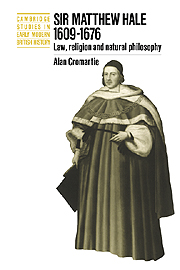13 - The Torricellian experiment
Published online by Cambridge University Press: 05 May 2010
Summary
Hale's ‘scientific’ interests covered a baffling range, but he published only three polemical works. An essay touching the gravitation or non-gravitation of fluids (1673) was followed by Difficiles nugae, or Observations touching the Torricellian experiment (1674; second edition with ‘Occasional additions’ 1675) and Observations touching the principles of natural motions (1677). All three were in some way concerned with a single much-discussed phenomenon:
a glass tube of three foot or more long, closed at one end, and then filled with mercury or quicksilver, and then the open end stopped with the finger, and inverted into a vessel of restagnant mercury; and when the end is sufficiently immersed, then the finger nimbly removed, so that no air get in, the mercury will subside in the tube to the height of 29 ins. and half an inch, or near thereabouts, but infallibly between 27 and 30 ins, leaving the residue of the upper end of the tube emptied of the mercury.
This ‘Torricellian experiment’ raised questions of the highest interest for the interpretation of natural events. Some believed that the column of metal was supported by the weight of air upon the open vessel; others believed the same phenomenon was explained by the abhorrence of a vacuum. Some thought that the space at the top of the tube was empty, others that it was occupied by something that had filtered through the mercury or glass, others again that it contained a vapour drawn out of the metal itself.
- Type
- Chapter
- Information
- Sir Matthew Hale, 1609–1676Law, Religion and Natural Philosophy, pp. 209 - 217Publisher: Cambridge University PressPrint publication year: 1995



